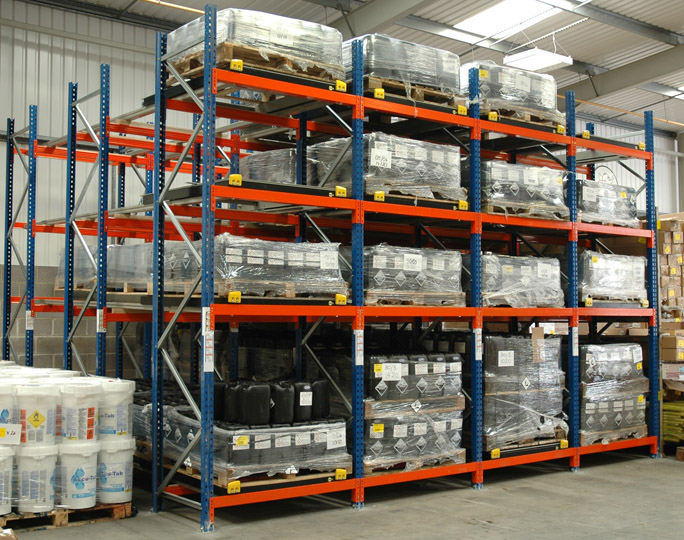The term ‘racking’ is used to describe a skeletal framework, of fixed or adjustable design, to support loads generally without the use of shelves. It is usually qualified (i.e pallet racking, tyre racking, drum racking, etc). Racking systems are widely used in warehouses as there are considerable space advantages over floor storage and they provide for easy access and retrieval of goods. There are many different types of racking system.
The basic principles for safe installation are as follows:
- Racking should only be installed by competent people in accordance with the manufacturer’s instructions. A programme of installation training is run under SEIRS (Storage Equipment Installers Registration Scheme.
- Racking should be erected on sound, level floors, capable of withstanding the point loading at each base plate.
- Where the racking design requires it to be secured to the building, only those building members that have been ‘proved’, by structural calculations, as able to resist the forces applied should be used. In such a case, the racking design should be compatible with the building layout.
- Double-sided runs should be connected and spaced using suitable run spacers.
- Where necessary, eg where lift trucks or other mechanical handling equipment are used, racking should be securely fixed to the floor
- Isles should be wide enough to ensure that mechanical handling equipment can be easily manoeuvred. Widths will depend very much on the type of equipment used, eg some require a 90° turn to load and offload, some remain parallel to the aisle and have forks at 90° to the direction of travel.
- Beam connector locks should always securely fix the connectors at the ends of each beam, to prevent accidental uplift of beams, eg by lift truck.
- Racking should have a clear unambiguous notice securely fixed to it, stating the maximum load together with any necessary specified load configurations.
- The limitations indicated in the maximum load notice should never be exceeded. The weight of each palletised load should be established before a decision is made to store it in the racking. This is particularly important where different products are stored which may vary considerably in weight, or where a new line of product is brought into the warehouse for the first time. In some situations, it may not be necessary to establish the weight of each palletised load, if the racking system is designed and installed to meet the storage requirements of the heaviest palletised load in your company’s operation. Nevertheless, you should adopt a system to ensure that all palletised loads intended for storage in racking can be safely stored in accordance with the particular racking design and installation.
- Racking should never be altered (eg by welding) nor components removed without first consulting the manufacturer. Before changing the position of adjustable components on racking (as supplied), you should establish the design limitations of the new configuration and, where necessary, amend the safe working load notice. Adjusting the position of the first or second beam from the bottom is normally the most critical alteration, which always requires check on the rated carrying capacity of the rack.
- High visibility colours for key components of the racking, eg horizontal beams, will assist truck operators to correctly position the forks and avoid damage to the racking.
Where racking is likely to be struck by lift trucks and other vehicles, it should be protected. Generally, such damage is at the lower levels of the racking – use renewable column guards to minimise the risk of damage from accidental impact. Corner uprights in a run of racking are especially at risk and should be suitably provided with a protective device in a conspicuous colour.
Retrofitting upright protection devices to an existing aisle where they have never been provided can have the effect of reducing the available clearances for fork-lift truck manoeuvres, which can in some circumstances increase the amount of damage caused. Such situations need consideration on a case-by-case basis.
Racking inspections and Maintenance
To ensure that a racking installation continues to be serviceable and safe, the storage equipment should be inspected on a regular basis. The frequency of inspections depends on a variety of factors that are particular to the site concerned and should be determined by a nominated ‘person responsible for racking safety’ (PRRS) to suit the operating conditions of the warehouse.
This will take into account the frequency and method of operation together with the dimensions of the warehouse, the equipment used and personnel involved, all of which could damage the structure. The inspection follows a hierarchical approach using several levels of inspection.
Immediate reporting
As soon as a safety problem or damage is observed by any employee, it should immediately be reported to the PRRS. You should have systems in place for reporting damage and defects. Employees should receive training, information and instruction on the safe operation of the racking system, including the parts affecting their safety and the safety of others.
Visual inspections
The PRRS should ensure that inspections are made at weekly or other regular intervals based on risk assessment. A formal written record should be maintained.
‘Expert’ inspections
A technically competent person should carry out inspections at intervals of not more than 12 months. A written report should be submitted to the PRRS with observations and proposals for any action necessary.
A technically competent person might be a trained specialist within an organisation, a specialist from the rack supplier, or an independent qualified rack inspector.
Normal rack inspections will be carried out from ground level unless there are indications of problems at high level that need investigation.











